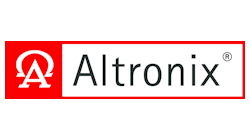New PoE and Data Transmission Solutions
IP continues to play a key role in nearly all aspects of physical security by enabling many different types of devices to easily be added to networks. With the exception of specialized applications for analog systems, security professionals have largely embraced the network integration systems model to improve overall situational awareness and security.
That said, many existing systems are built on legacy infrastructure, which is expensive to rip and replace with structured cable, or require the distance and bandwidth advantages of fiber. This has created strong market demand for new power and transmission solutions that bridge the gap between various forms of infrastructure.
When designing and deploying a state-of-the-art access control and/or surveillance system using new or existing infrastructure, it is paramount to consider the low-voltage power requirements of every device on the network. Installing the proper power and data transmission products is essential for reliable operation and seamless integration, ensuring that the best possible foundation is in place to support all connected devices and provide greater security.
Ethernet over Coax (EoC) Solutions
New Ethernet over Coax (EoC) media converters are the latest solutions that address the upgrade of analog to IP by repurposing coax cabling, which yields substantial savings. These media converters provide the additional benefit of providing both power and data over a single coax cable, supporting PoE, PoE+ and Hi-PoE devices while reaching distances up to 500m – five times standard Ethernet range.
EoC media converters are available in many different configurations to fulfill a range of installation needs – from single- to multi-port receivers with integral switches in indoor and hardened models. New EoC solutions also now include fiber (SFP) ports and more power to further bridge coax, Ethernet and fiber on a unified infrastructure platform.
Making the Fiber Connection
Millions of miles of fiber have been stretched under highways and throughout cities across the US for surveillance cameras and other applications; however, the costs to implement these devices are expensive given the need for localized power. The continued evolution of Ethernet-to-fiber media converters delivers a new level of flexibility for today’s advanced IP systems. For example, new injectors, switches and media converters feature SFP ports that accommodate fiber optic cable to deploy devices at greater distances with faster throughput. This allows the extension of physical IP security and surveillance devices far beyond coax and IP cabling, and the deployment of these solutions in areas where local power supplies do not exist or cannot easily be deployed.
In fact, IP cameras and myriad other physical security devices can be deployed at distances beyond 5000 feet while delivering power and data from the head-end utilizing composite single-mode fiber optic cable. This greatly extends the reach of perimeter security and increases situational awareness.
Advanced Ethernet-to-fiber media converters are available in a wide assortment of configurations including indoor and outdoor models with hardened Ethernet PoE+ switches, and rack mount media converters with or without integral power. These units can be deployed with conventional single or multi-mode fiber, as well as composite cable to simultaneously deliver both power and data.
The Benefits of Remote Management
PoE EoC media converters and PoE Ethernet-to-fiber injectors, switches and media converters have a significant impact on how systems are designed and deployed. With the addition of network communications now available in these foundation power and data transmission products, systems designers and integrators can lower Total Cost of Ownership (TCO) while providing higher levels of integration that enable remote monitoring, diagnostics and control.
Using the data provided by the networked products, integrators can quickly identify and mitigate potential and actual system issues prior to dispatching technicians – saving time, reducing expenses and increasing efficiency. Early intervention, preventative maintenance and service calls (when necessary), can be handled with a higher degree of accuracy while improving overall security and operations. The tangible benefits of power and data transmission products with network communications provide an all-encompassing networked system solution for the professional security industry at large.
Consider a scenario where there is a system issue involving a security device. When troubleshooting, the power source is often the first point to be checked, but is typically not the problem. Power solutions with embedded network communications can help to easily pinpoint the cause of the problem by monitoring all the connected devices. The information provided by advanced power solutions with network communications reduces system downtime, helps eliminate service calls and provides faster response times.
In addition to improving overall reliability, these characteristics can also significantly reduce end-users’ TCO through more efficient service management. Simple tasks such as rebooting devices remotely and scheduling battery maintenance can be easily accommodated with new smart power and transmission solutions.
Increased RMR
New advanced power and data transmission solutions with embedded network management features provide benefits for both integrators and end-users. For integrators, the ability to remotely monitor power diagnostics in real-time from virtually anywhere over the network represents a new source of RMR.
The data and alerts these solutions provide make it possible to quickly identify and mitigate potential and actual system issues prior to dispatching technicians, which saves time, reduces expenses, increases efficiency and improves overall security. Another key benefit is that preventative maintenance and service calls can be handled more accurately. In short, with network communication capabilities, new power and transmission solutions provide a more holistic approach to systems integration.
For end-users, power and data transmission solutions with embedded network management features improve overall security by reducing system downtime. TCO is also reduced through more efficient service management; while tasks such as rebooting devices remotely, updating software and scheduling maintenance are streamlined.
Power and data transmission devices with network communications and management capabilities are quickly becoming the new foundation for today’s advanced integrated surveillance, access, and security systems. It is time well spent for resellers and end-users alike to familiarize themselves with these new solutions as they can increase overall performance, while actually reducing both short and long-term expenses.
Ronnie Pennington is National Sales Engineer for Altronix Corp. Request more info about the company at www.securityinfowatch.com/10212790.



